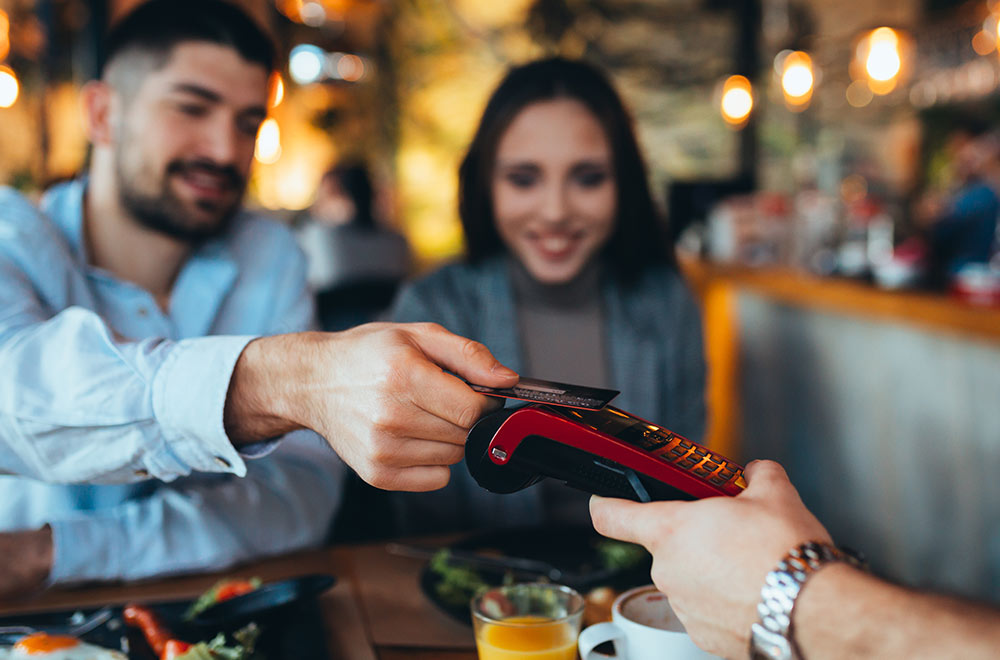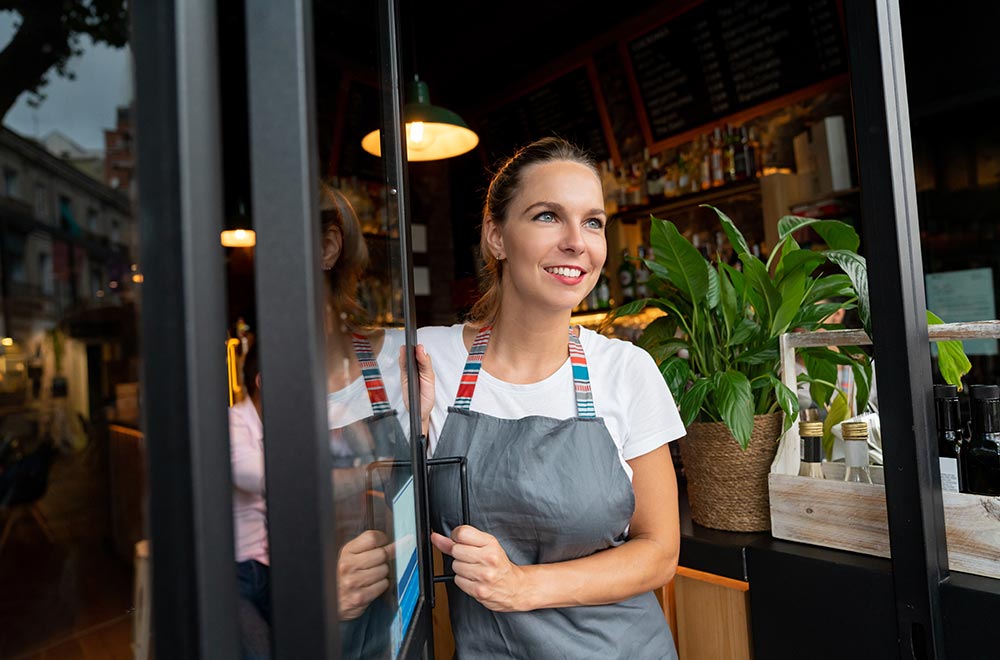As shelter-in-place orders lift, restaurants throughout parts of the country are reopening their doors for dine-in service. But as you know, dine-in service in the coronavirus era is far from “business as usual” as there are various expectations that need to be set, guidelines that need to be communicated, and parameters that need to be followed.
In this article, we touch on the primary elements that need attention when you open your doors. Every idea and checkpoint may not apply to you, but our restaurant marketing and operations experts have compiled this document to help guide your reopening efforts.
As you read this guide, remember that in the COVID-19 era more than ever, regulations impacting your ability to open for dine-in service, and how you do it, are hyper-local. Please remember to check state and local regulations before implementing any of these strategies for success.
Ease into full-service dining
When navigating the challenges spurred by COVID-19, it’s easy to feel like you have to jump full force back into dine-in service at the earliest opportunity. Try to resist this urge. Rather, it’s a good idea to start slow and build your on-premise dining business back up steadily over time as patrons begin to feel comfortable dining outside their homes again.
Takeout and delivery can remain a core component of your business and the bulk of your revenue as dine-in service will most likely be limited to start. You can consider ramping up these sales even further by offering discounts on pick-up orders when directly placed through your restaurant instead of a third-party service. By prioritizing in-house and direct takeout and delivery orders, you can start to pull away from any third-party apps you partnered with in order to recoup the maximum amount of each sale instead of giving a large chunk to commission fees.
Due to social distancing and reopening protocols, owners and operators can expect a reduced dine-in occupancy rate. It’s a good idea to put stipulations in place as it pertains to the maximum number of guests allowed per table as well as how many people can congregate in the entrance of your restaurant while waiting for a table. Brainstorm ideas with your staff on how to best plan for a seamless seating experience. This can include limiting the number of people in your waiting area as well as establishing an outdoor area and plan for overflow. Encouraging customers to make a reservation prior to arriving at your restaurant can help your staff accurately gauge the number of guests and appropriate considerations that need to be made on a day-by-day basis.

Set clear and realistic expectations
It’s wise to communicate your restaurant’s new guidelines early and often with your customer base. Have a section on your website’s homepage that explains any pertinent changes that are going into effect as well as a way for visitors to contact you with any questions/concerns. Adding an FAQ section to your site that’s specific to dining in your restaurant during coronavirus can be especially helpful for customers, setting concrete expectations before they come in to dine. Also, you can send an email blast out to your entire contact list and post on your social platforms letting everyone know what to expect when they visit your restaurant after it reopens for limited dine-in service. Consider posting sidewalk and window signage that explains the guidelines and requirements for people entering your restaurant, so that no one is met with any surprises upon entering.
During this ramping up timeframe, restaurant owners can offer a limited menu that features their bestsellers and high profit margin items. Update your website’s menu to reflect these changes, post a new limited menu in your establishment’s front window, and make announcements across all your social platforms. It’s important for guests to be aware of their meal options prior to coming through your doors so you can mitigate expectations and align them with the reality of today’s situation. To continue this communication stream while customers are dining, your staff can place table tents on every table that list the new safety measures and dine-in requirements. This may include points such as requiring diners to wear a mask anytime they leave their table, alerting people that condiments are only available upon request, and the maximum number of guests allowed per table. By establishing the guidelines and dine-in parameters up front, restaurant owners are able to proactively plan for a successful dining experience for all parties — guests, staff, vendors, and management.
Prioritize safety above all else
Safety and sanitation are on the top of everyone’s minds these days. It’s crucial to remain rigorous with your restaurant’s sanitation routine to prevent any staff or guests from being infected with or spreading COVID-19. Consider scheduling a deep cleaning service at least once a week to ensure that every area from floors and tables to kitchen appliances and walls are disinfected and cleaned to the highest standard. It’s also a good idea to plan for your staff to have longer dinner/closing shifts so that they can extensively clean the restaurant each night.
Small prevention measures can go a long way not only toward mitigating the risk for infection, but to put guests’ minds at ease too. Add hand sanitizer and/or disinfecting hand wipes at each table, in the bathroom, and at various stations throughout the restaurant, making it easy and convenient for patrons to sanitize multiple times during their visit. Section off the tables that are not being used due to social distancing and clearly delineate between the waiting area(s) and dining sections of your restaurant. Other procedural changes may be enacted to bolster safety and sanitation measures such as discontinuing high-traffic guest areas like salad bars, buffets, and beverage service stations. Finally, ensure that your carry-out and delivery procedures include no-contact options and that you’re using tamper-evident food packaging.
Prior to reopening for dine-in service it’s a good idea to have an all-staff education meeting to ensure that everyone is on the same page. Explain that your top priority is their health and the health of any people that come through your doors. Drive home to your employees how important it is for them to maintain a healthy diet, get plenty of sleep, regularly exercise, and take care of their mental health during these unpredictable times. Other staff safety and health guidelines can include:
- Discouraging unnecessary travel
- Regular temperature checks
- Requiring masks for all employees and customers
- Instructing your staff to wear gloves at all times
- Mandating that sick employees stay home
- Regularly washing/sanitizing hands throughout shift
- Keep employees at least six feet from one another
If you’re looking for tips on how to maximize the safety of your staff and guests, a great resource is the National Restaurant Association’s “COVID-19 Reopening Guidance” that provides restaurant owners with a framework on how to safely reopen their doors during these times.
Manage your menu and costs
One of the most important facets of reopening dine-in service is determining what dishes will be on your new limited menu. To do so, you can run a report to unearth which selections are the most popular as well as which items garner the highest profit margins. Try to keep your staples and most well-known dishes as intact as possible to maintain brand recognition and customer satisfaction. It’s a savvy idea to apply these same principles to your takeout/delivery menu, along with taking into account which food items travel best, to ensure continuity across all dining avenues.
Continue to work with your suppliers and vendors to find strategic ways of keeping your in-house inventory small. Also, regularly run a cash flow analysis to see what areas of the business are performing well and where further optimization is needed. Creating out-of-the-box opportunities for revenue is a key differentiator among restaurants nowadays. Take stock of the overflow ingredients your establishment has on hand and determine if assembling take-home meal kits is a viable option. Some restaurants are also opting to open online “grocery stores” that sell pantry staples such as flour, eggs, milk, bread, and condiments directly to consumers. The more outlets a restaurant owner can create for the public to support their business, the better a chance they have of coming out of the coronavirus era as financially unscathed as possible. To learn more about aligning supplier orders to your new normal and other best practices for preparing your restaurant to successfully reopen, check out our blog, “How restaurants can successfully reopen in the coronavirus era.”

Leverage technology and your web presence
Make your current technology work better for your specific situation as you navigate reopening dine-in services during coronavirus. Automated ordering systems, including mobile ordering apps and cashless payment options, are an effective no-contact means to place and cash out guests’ orders. Other tech-forward approaches to reduce staff to guest contact, while keeping customers informed and comfortable, can include:
- Texts/phone calls when tables are ready
- Regular web updates that announce pertinent information
- Weekly email blasts to discuss any changes, rules, modified menu items, etc.
- Ability to make reservations online
- Large-print online menus that reflect real-time availabilities
When it comes to any brand’s social media platforms, transparency is key. Determine a posting schedule and cadence that accounts for about two to three posts per week. These can be informational, alerting followers that you’re open for dine-in service and of any new promotions you’re running, or more fun and informal, featuring mouthwatering food photography and snaps of your restaurant and staff in action. Social media is also an effective real-time outlet for businesses to share what measures they’re putting in place to adhere to coronavirus guidelines and best practices as it relates to health and safety. Continue to encourage engagement by posting questions, polls, and timely information as it relates to your restaurant’s latest happenings and offerings, directing readers to other resources on your website. Finally, because Google and other general sites may not have the most up-to-date information on your restaurant, it’s a good idea to frequently check your channels to answer comments, reply to questions, and address direct messages.
In addition to posting on your website and social channels, you may want to alert your local media that your restaurant will be open for limited dine-in service. When connecting with public relations and media professionals, try to curate a unique angle to allow your email/phone call to stand out from the others they receive each day. If you have done something exceptional to take care of your staff during this time or if one of your team members has a particularly noteworthy story, this can be a great approach to take. Assemble a strong library of marketing materials that includes logos, photos of your restaurant and dishes, as well as photos of staff to share with the media when the time comes. If you have the capabilities, consider creating your own video content such as cooking demonstrations and how-to recipe videos as these can be a great addition to any media package.
Since most people are not currently adhering to regular office hours, it’s a smart move to extend dine-in promotions and happy hours to times of the day that are typically off hours. For example, you can try offering a special lunch deal 1 p.m. – 4 p.m. and then extended drink discounts 8 p.m. – close, enticing patrons to make a reservation at your spot during these time slots. Again, getting creative and testing different promotions and ideas can fuel and funnel revenue through different arms of your business so that your bottom line isn’t hinging on only takeout/delivery orders or solely dine-in dollars.
Control what you can
The coronavirus pandemic has produced many uncertainties and challenges for the restaurant industry that seem to ebb and flow daily. As a business owner, it’s easy to become overwhelmed by just the idea of reopening your restaurant’s dine-in service. It’s important to focus on the aspects of your business that you can control such as staff/guest safety requirements, setting clear expectations for diners, increased sanitation efforts, new menus, takeout/delivery protocols, and communication efforts. By taking a slow and steady approach to dine-in service during COVID-19, restaurant owners can set themselves up for continued success and consistent revenue streams, while boosting their brand recognition and customer satisfaction goals.
Take a look at our free e-tool, “Coronavirus Era: 13 Restaurant Marketing Tips” to discover restaurant marketing strategies and tactics that can help your business during COVID-19.






